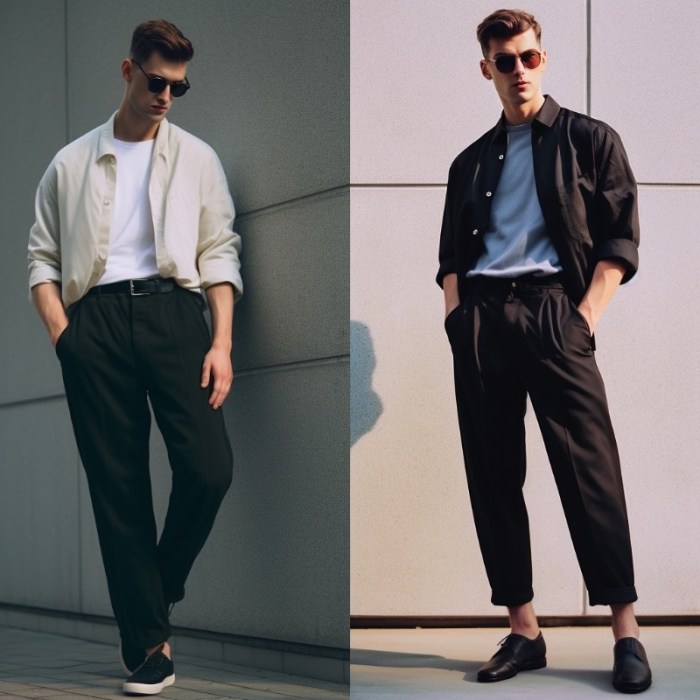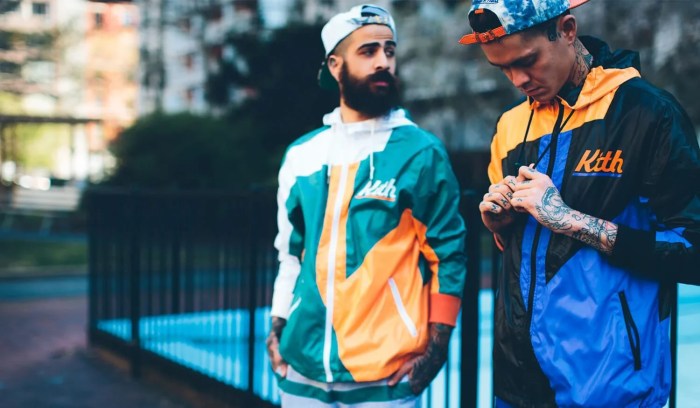1969 Mens Fashion A Style Retrospective
Key Styles of 1969 Men’s Fashion
1969 men’s fashion reflected a dynamic period of social and cultural change, showcasing a blend of established styles and emerging trends. Silhouettes, fabrics, colors, and patterns all played a role in defining the sartorial landscape of the year.
Prevalent Silhouettes of 1969 Menswear
The silhouettes of 1969 menswear were diverse, reflecting the varied subcultures and social classes. While the slim, tailored look of the early 60s was still present, particularly among affluent men, a more relaxed and casual fit began to gain traction, particularly among younger generations. This included wider-legged trousers, looser-fitting jackets, and a general move away from the constricting styles of previous decades.
Characteristic Fabrics Used in Men’s Clothing During 1969
The fabrics used in men’s clothing during 1969 were as varied as the styles themselves. Traditional materials like wool and cotton remained popular for suits and outerwear, but synthetic fabrics like polyester and nylon were increasingly used in casual wear, reflecting the growing affordability and availability of these new materials. Denim, a staple of working-class and youth culture, experienced a surge in popularity, particularly in the form of jeans and jackets.
Key Colors and Patterns Popular in 1969 Men’s Fashion
The color palette of 1969 men’s fashion was influenced by both established trends and the burgeoning counterculture movement. Earth tones like browns, greens, and beige remained prevalent, especially in more conservative styles. However, brighter colors like vibrant blues, oranges, and yellows also gained prominence, often seen in casual wear and garments associated with youth subcultures. Patterns ranged from classic pinstripes and checks to more psychedelic and bold designs reflective of the era’s artistic experimentation.
Comparison of Working-Class and Affluent Men’s Fashion in 1969
A clear distinction existed between the fashion choices of working-class and affluent men in
1969. This difference is highlighted in the table below:
| Feature | Working-Class | Affluent |
|---|---|---|
| Silhouette | More relaxed fit, functional clothing | Slim, tailored suits, sharp lines |
| Fabrics | Denim, cotton work shirts, durable materials | High-quality wool, silk, cashmere |
| Colors | Earth tones, practical colors | More varied color palette, including bolder shades |
| Patterns | Plain or simple patterns | Pinstripes, checks, more sophisticated patterns |
Influence of Subcultures on 1969 Men’s Fashion
The counterculture movement of the late 1960s significantly impacted men’s fashion in 1969. Different subcultures, each with its own unique aesthetic, contributed to the diversity and rebellion evident in the clothing of the time. This challenged the established norms and helped shape the evolving trends of menswear.
Impact of the Counterculture Movement on Men’s Clothing Choices
The counterculture movement promoted self-expression and a rejection of mainstream values, leading to a significant shift in men’s fashion. This rejection manifested in a move away from the conservative styles of previous decades towards more individualistic and expressive clothing choices. The emphasis shifted from conformity to individuality, creating a more diverse and dynamic fashion landscape.
Styles Adopted by Different Subcultures
Different subcultures embraced distinct styles. Hippies, for example, favored flowing garments, natural fabrics, and earth tones, often incorporating handcrafted elements. Mods, on the other hand, maintained a more tailored look but with bolder colors and patterns, often incorporating elements of Italian and American styles. These distinct styles visually represented the different ideologies and lifestyles of these groups.
Comparison of Rebellious Youth and Established Generation Styles

Source: thefashionisto.com
The clothing styles of rebellious youth sharply contrasted with those of the established generation. While older generations generally adhered to more traditional and conservative styles, younger generations used clothing as a form of rebellion and self-expression, embracing unconventional fabrics, silhouettes, and patterns. This stark contrast reflected the generational divide and the changing social landscape.
Specific Garments Associated with Each Subculture
Specific garments became strongly associated with each subculture. For hippies, bell-bottom jeans, paisley shirts, and long hair were defining features. Mods favored tailored suits, sharp shirts, and scooters, creating a distinctly urban and stylish image. These garments became visual representations of their respective identities and beliefs.
Iconic 1969 Men’s Fashion Icons and Trends
Several prominent figures influenced 1969 men’s fashion, shaping trends and inspiring styles that continue to resonate today. Specific garments and styles became iconic, symbolizing the era’s spirit of rebellion and change. Analyzing these icons and trends offers insight into the fashion landscape of 1969.
Prominent Male Figures Who Influenced 1969 Men’s Fashion
While pinpointing exact influence is difficult, musicians like Jimi Hendrix, with his flamboyant style, and actors like Steve McQueen, known for his effortlessly cool aesthetic, significantly impacted men’s fashion in 1969. Their individual styles, reflecting their personalities and artistic expressions, influenced broader trends and inspired countless imitators. Additionally, political figures, though less directly influential on specific garments, shaped the overall social climate that impacted fashion choices.
Iconic Garments and Styles of 1969
Bell-bottom jeans, paisley shirts, and leather jackets became iconic garments of the era. These items transcended subcultural boundaries, becoming widely adopted and representing the spirit of the times. The prevalence of these items signifies their cultural significance beyond mere clothing.
1969 men’s fashion saw a dramatic shift towards more relaxed styles, a departure from the previous decade’s formality. This move towards casual wear is interesting when compared to the more structured and elaborate styles of the 1880s fashion men , which featured tailored suits and ornate accessories. The contrast highlights the evolving perceptions of masculinity and societal norms across these different eras, ultimately shaping the distinctive characteristics of 1969 menswear.
Visual Representation of a Typical 1969 Male Outfit, 1969 men’s fashion
A typical 1969 male outfit might consist of a brightly colored paisley shirt, slightly flared bell-bottom jeans, and a suede or leather jacket. The shirt could feature bold patterns, the jeans would be a mid-to-dark wash, and the jacket could be brown, black, or even a vibrant color. The overall look would be relaxed yet stylish, reflecting the casual yet expressive nature of the era’s fashion.
Top Five Most Influential Fashion Trends of 1969 for Men
- Bell-bottom jeans: Wide-legged jeans that originated in working-class communities but were adopted by various subcultures, signifying rebellion and individuality.
- Paisley shirts: Boldly patterned shirts, often in vibrant colors, associated with the hippie movement and its emphasis on natural fabrics and free expression.
- Leather jackets: A symbol of rebellion and counterculture, leather jackets offered a tough and stylish image.
- Mod suits: Sharp, tailored suits in bold colors and patterns, reflecting the clean-cut style of the Mod subculture.
- Longer hair: A significant shift from previous decades, longer hair became a symbol of rebellion and self-expression, challenging established norms.
Evolution of Men’s Fashion from the 1960s to 1969
Men’s fashion underwent a significant transformation from the early to the late 1960s, driven by social and cultural changes. This evolution is evident in shifts in silhouette, fabrics, colors, and overall style. Understanding this evolution provides context for the fashion landscape of 1969.
Evolution of Men’s Fashion from the Early 1960s to 1969
The early 1960s were characterized by slim, tailored suits and conservative styles. By 1969, however, a more relaxed and individualistic approach had emerged, with wider-legged trousers, looser-fitting jackets, and a greater variety of colors and patterns becoming increasingly prevalent. This shift reflected the changing social attitudes and the rise of youth counterculture.
Social and Cultural Factors Contributing to Changes in Men’s Style
The counterculture movement, the Vietnam War, and the growing emphasis on self-expression were all significant factors driving the evolution of men’s fashion. These social and political upheavals influenced the desire for a break from traditional styles and a move towards more individualistic and expressive clothing choices.
Comparison of Early and Late 1960s Men’s Fashion
The early 1960s emphasized conformity and a clean-cut look, while the late 1960s embraced individuality and self-expression. This contrast is evident in the shift from slim-fitting suits to more relaxed silhouettes, the introduction of bolder colors and patterns, and the rise of subcultural styles.
Specific Shifts in Silhouette, Fabrics, and Colors
The shift from slim-fitting suits to looser silhouettes was a defining change. The use of more casual fabrics like denim and the increased prevalence of bolder colors and patterns further distinguished late 1960s fashion from its earlier counterpart. This evolution marked a significant departure from the conservative styles of the past.
The Impact of 1969 Men’s Fashion on Subsequent Eras
The fashion of 1969 left a lasting impact on subsequent decades, with specific elements being revisited and reinterpreted in modern menswear. This cyclical nature of fashion trends is clearly illustrated by the enduring influence of 1969 styles. The legacy of this era continues to shape contemporary fashion choices.
Lasting Influences of 1969 Men’s Fashion on Subsequent Decades
The relaxed silhouettes, bold patterns, and use of denim from 1969 continue to influence modern menswear. Elements like bell-bottom jeans, though not always in their original form, have been repeatedly incorporated into contemporary styles, showcasing the enduring appeal of these classic designs.
Revisited and Reinterpreted Elements of 1969 Style in Modern Menswear
Designers frequently draw inspiration from 1969, incorporating elements like paisley prints, flared trousers, and suede jackets into modern collections. These reinterpretations often blend classic 1969 styles with contemporary design elements, creating fresh and relevant looks.
Cyclical Nature of Fashion Trends: 1969 as a Case Study

Source: apetogentleman.com
The cyclical nature of fashion is evident in the recurring popularity of 1969 styles. Trends from this era reappear in updated forms, demonstrating how fashion often revisits and reinterprets past styles, adapting them to contemporary tastes and contexts.
Examples of How 1969 Fashion Continues to Impact Current Trends
- The resurgence of flared trousers and bell-bottoms.
- The continued use of paisley patterns in shirts and other garments.
- The enduring popularity of leather jackets in various styles.
- The incorporation of earth tones and natural fabrics in contemporary menswear.
- The ongoing influence of relaxed silhouettes in casual wear.
FAQ Section
What were some common accessories worn by men in 1969?
Common accessories included leather belts, bolo ties, scarves (especially bandanas), and sometimes jewelry like rings or necklaces, depending on the subculture.
How did the Vietnam War influence 1969 men’s fashion?
The war indirectly influenced fashion through the anti-war movement and the counterculture’s rejection of established norms, leading to more casual and expressive styles.
Were there any significant differences in men’s footwear during this time?
Yes, styles ranged from classic dress shoes to more casual boots and loafers. The choice often reflected social class and subcultural affiliation.





















